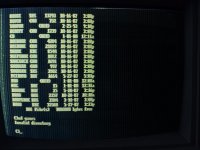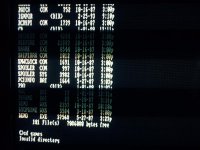vladstamate
Experienced Member
Ok,
So I finally got a keyboard for my Tandy 1000 and booted it up again. No matter if I connect it to a CGA monitor or a TV (using composite) the video is ineligible. Here are two images attached, one from my CGA monitor and one from the TV. The green one is the CGA monitor. I must add that the longer I let it on the worse the image was on the CGA until after 10 minutes it was just a mess of dots and lines....
So question:
1) Is my CGA dying or is the Tandy bad? I remember connecting it to my PC XT and it was better than that a while ago.
2) Is the composite normal to be that bad? How did IBM ever thought IBM PCjr was ok to connect to TV using composite?!
3) What can I do to actually use my Tandy as in the condition that is now I cannot see anything that I can understand when I type "dir".


Regards,
Vlad
So I finally got a keyboard for my Tandy 1000 and booted it up again. No matter if I connect it to a CGA monitor or a TV (using composite) the video is ineligible. Here are two images attached, one from my CGA monitor and one from the TV. The green one is the CGA monitor. I must add that the longer I let it on the worse the image was on the CGA until after 10 minutes it was just a mess of dots and lines....
So question:
1) Is my CGA dying or is the Tandy bad? I remember connecting it to my PC XT and it was better than that a while ago.
2) Is the composite normal to be that bad? How did IBM ever thought IBM PCjr was ok to connect to TV using composite?!
3) What can I do to actually use my Tandy as in the condition that is now I cannot see anything that I can understand when I type "dir".


Regards,
Vlad
